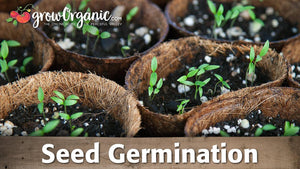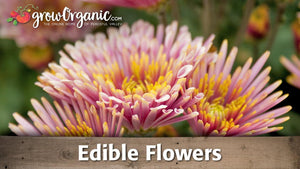Item Number: SWF5040
Moonlight Climbing Nasturtium Flower Seeds
Soft Primrose Color Climber
Annual - These lovely climbing nasturtiums have charming soft primrose yellow flowers and bright green foliage, much different than the usual bold and brassy color mix. They grow easily in any well-drained soil and will gracefully disguise neglected areas or climb up a fence, trellis or wall, providing a summer arbor of pretty lily-pad shaped leaves and long-spurred flowers. As a wonderful bonus, both the bright flowers and leaves are deliciously edible with a spicy watercress flavor.
Soil & Water: Climbing nasturtiums are easy to grow in any well-drained soil. Fertilizer is usually not necessary and too much nitrogen will create bountiful foliage without much flowering. You'll need to train young plants onto their supports with loose ties, then they'll climb easily and bloom non-stop. Do not let plants dry out during blooming season.
Planting & Growing:To Start Outdoors: Sow seeds in spring, once all danger of frost is over, in full sun (or part shade in hot climates). Poke seeds into well-worked soil about 1" deep and 3 - 4" apart. Press soil firmly over the seeds and keep moist. When seedlings are large enough to handle, thin to stand 10" apart, or 6 - 8" apart if training seedlings up vertical supports. To Start Early Indoors: Sow 2 seeds in individual 4" pots of well-drained seed starting mix 3 weeks before last expected frost date. Cover 1" deep. Provide a strong light source. When seedlings have several sets of leaves, pinch out the weaker seedling leaving 1 seedling per pot. When weather is evenly in the 50's, gradually acclimate to outdoor conditions. Transplant as above in full sun.
Soil Temperature: above 50°FPlanting Depth: 1"
Germination: 7-14 Days
Height At Maturity: 4-6 feet
Sun/Shade: Full to Partial Sun
Spacing After Thinning: 10"
Approx Seeds per Pack: 40-45 Seeds
Check Your Zone Compatibility:
Compatible with your zone.
Growing Zone for

Our Guarantee To You
Since 1976, we've served our customers at every stage of growing. Please contact us at any time. We are happy to support and assist you.
Shipping Information
Shipping Information
Shipping Weight: 0.01 lb
Dimensions: 4.5"L x 3.125"W x 0.1"H
Features
Features
- Attracts Beneficial Insects
- Attracts Hummingbirds
- Edible Flower
- Good Fall Color
- Good for Beginners
- Grow on a Trellis
- Heirloom
- Requires Staking
- Requires Summer Water
- Useful for Ornamental
Characteristics
Characteristics
Planting & Care
Planting & Care
Soil & Water: Climbing nasturtiums are easy to grow in any well-drained soil. Fertilizer is usually not necessary and too much nitrogen will create bountiful foliage without much flowering. You'll need to train young plants onto their supports with loose ties, then they'll climb easily and bloom non-stop. Do not let plants dry out during blooming season.
Planting & Growing:To Start Outdoors: Sow seeds in spring, once all danger of frost is over, in full sun (or part shade in hot climates). Poke seeds into well-worked soil about 1" deep and 3 - 4" apart. Press soil firmly over the seeds and keep moist. When seedlings are large enough to handle, thin to stand 10" apart, or 6 - 8" apart if training seedlings up vertical supports. To Start Early Indoors: Sow 2 seeds in individual 4" pots of well-drained seed starting mix 3 weeks before last expected frost date. Cover 1" deep. Provide a strong light source. When seedlings have several sets of leaves, pinch out the weaker seedling leaving 1 seedling per pot. When weather is evenly in the 50's, gradually acclimate to outdoor conditions. Transplant as above in full sun.
Useful Information
Useful Information
Guarantee
Guarantee
Share
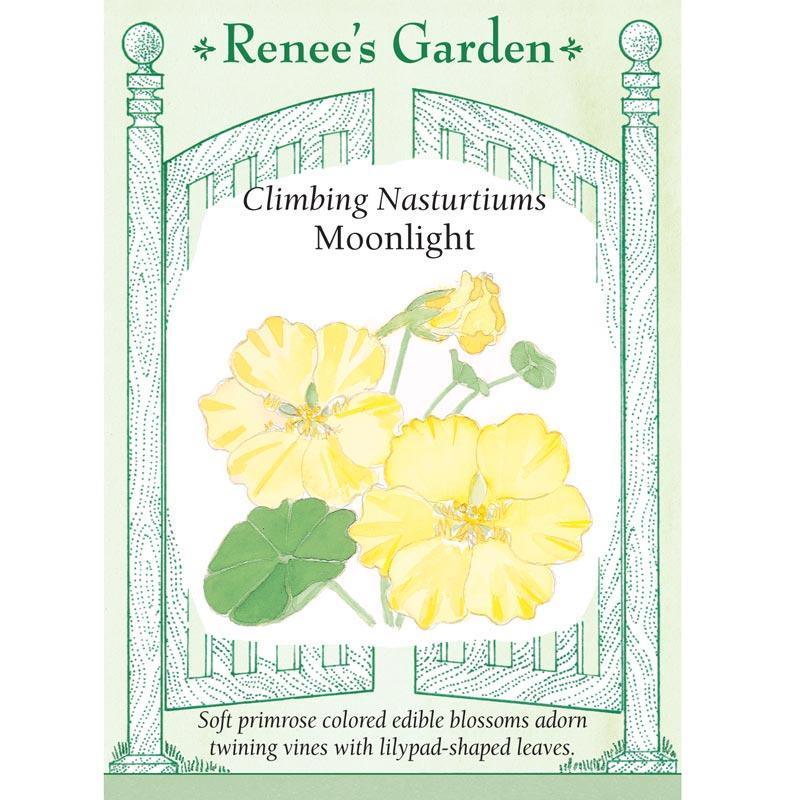
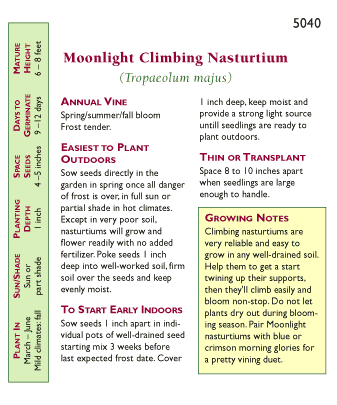
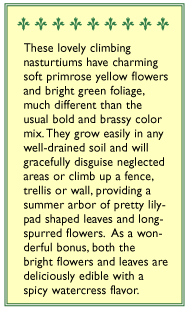
Something about the off-white ivory buds and flowers is surprisingly appealing. They self sow in my dooryard, but I also plant them for mixed containers to retail at my farm, and I have harvested the vines for cut flower arrangements Vines are delicate, but buds continue to open in the vase. Adorable, one of my favorite nasturtiums. Self-sown volunteers begin growing in mid-June after the poppies are over, and fill in those spots vacated by spring bloomers well with a floriferous parade until frost.
I love the buttery color of the flowers of this climbing, rambling nasturtium. Great packaging with plenty of information on the plant itself and how to start - and excellent germination rate.
Love these pretty little yellow climbing nasturtiums called Moonlight.




